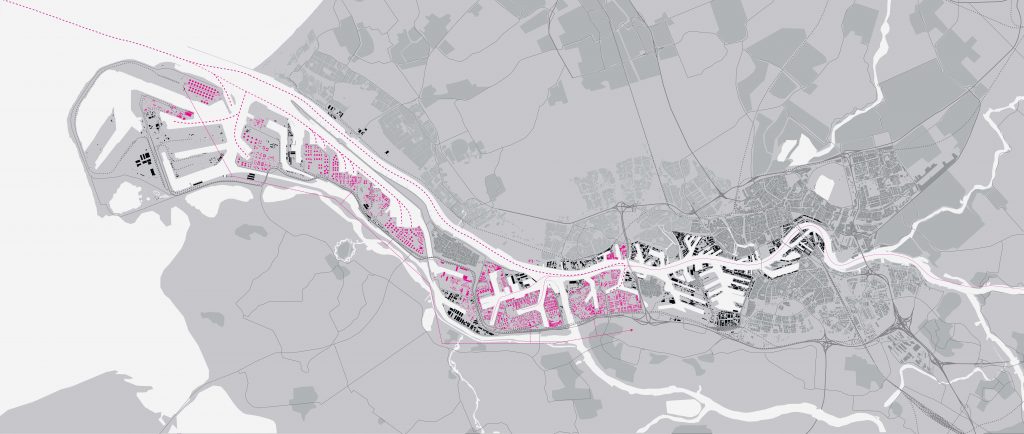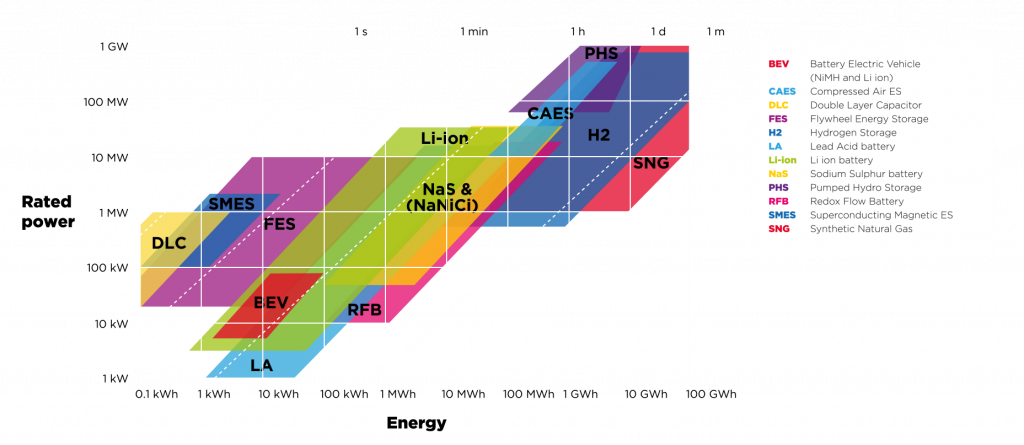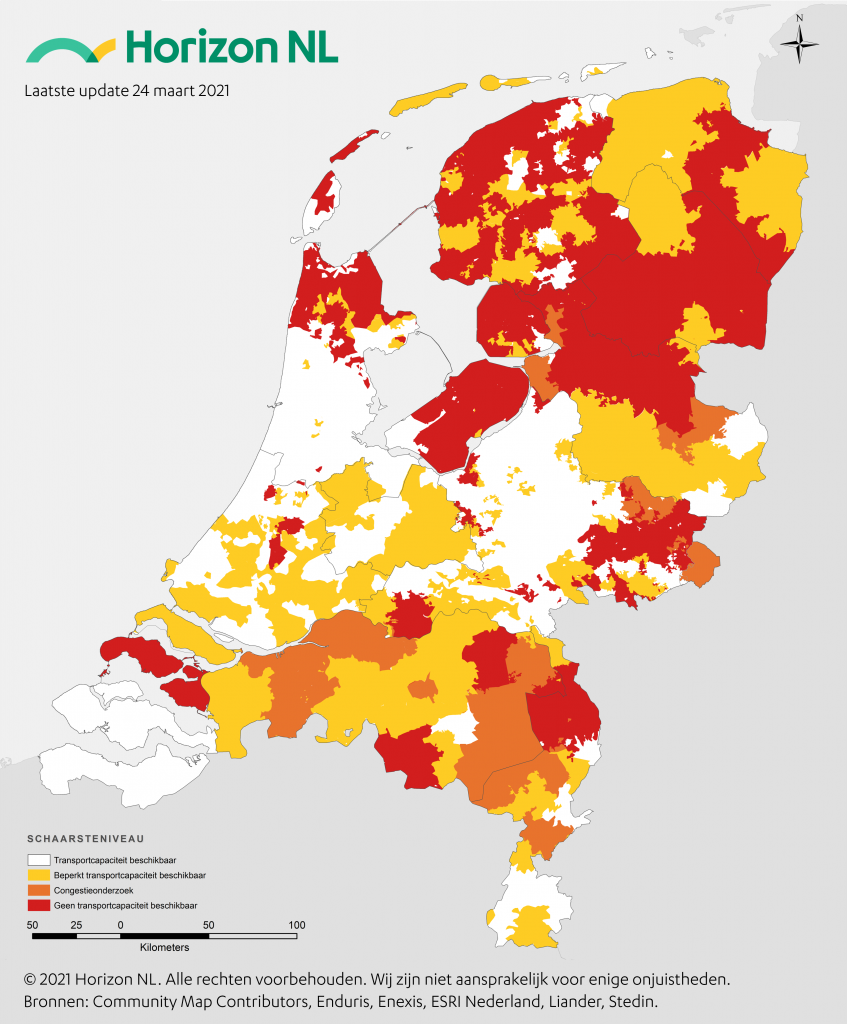History intertwined with fossils
Rotterdam was the world’s busiest port from 1962 to 2004 [1], growing steadily from 1910 onwards. Its harbor and oil-industry are strongly intertwined, as can be seen from analytical maps [2] showing industrial, infrastructural, retail, administrative, and ancillary spaces over a period of some 90 years. The result is referred to as the port’s ‘petroleumscape,’ in line with Carola Hein’s definition of which the year-2015 version is shown in the following image [3]. Five large oil-refineries form the core of the petrochemical cluster in this port area. These oil refineries manufacture products such as gasoline, diesel, kerosene, heating oil and feedstock for the chemical industry [4]. One could say that oil built this port, the one would not exist without the other.

However, the Climate Act [5] adopted in The Netherlands prescribes a 95% reduction in GreenHouse Gases (GHGs) in 2050 combined with a fully CO2-neutral electricity production. This means the inseparable connection between fossil energy carriers and the port becomes problematic if not a cul-de-sac. Especially when we consider how little time remains to achieve our non-fossil future (today-2050) and the need for urgent action.
Steering the Mammoth Tanker
Many initiatives are already underway to reduce our emissions, but the question is whether they are too little too late. As a country of consensus, the Netherlands require broad and intensive consultation. After the government accepted the Climate Act, all 352 (year 2021) townships were charged with executing near impossible goals through local interventions. These are all bottom-up initiatives which lack a shared, overarching ‘Delta Plan’ approach. The townships are supported in their planning by a variety of government-related organizations, with the goal of producing 30 Regional Energy Strategies. The question arises whether this will lead to the required national goals or to a broad patchwork of incompatible interventions and a loss of valuable time to act.
Another risk involved with the time pressure and bottom-up approach is the choice of proven over new technologies, leading to possible lock-in scenarios. An example of such a lock-in scenario might be the transport of (existing) waste heat from Rotterdam’s cluster to, among others, the city of Leiden through a ‘heat roundabout’ over large distances. We cannot tell whether the future heat source will be GHG-free, what the costs for the end users will be, how secure the supply will be and how to scale the system. Nevertheless, local authorities are pressed to decide on such technologies now, potentially missing out on viable alternatives and committing to future stranded assets like the aforementioned roundabout. This artificial time pressure can mean rushing decisions and committing to ’less-bad’ technologies at the expense of durable long-term policies, with current technology pushed at the expense of real lasting solutions which can contribute to climate goals. As prime-minister Mark Rutte stated: “Carbon Capture and Storage is a transition technology”, meaning that the process of capturing CO2 and just storing will only postpone the real interventions necessary.
Other possibilities exist that are suitable for an intermediate phase. For instance, converting the oil-refineries to bio-refineries and using the nearby greenhouse industry for the needed biological feedstock production. These options were set out in the transition pathway ‘Circular Economy’ within the ‘Roadmap Next Economy’-study for this region, led by Jeremy Rifkin. A synergetic cooperation between adapted obsolete fossil based infra structure and new biobased agriculture as it is planned amongst others in Sardinia [6]. In addition to more profitable use of existing infrastructure and a possible reduction in GHG-emissions, time is bought to research new technologies and possibilities for cleaning up brownfield sites, the costs of which will be tremendous. In this way fossil-based companies, which have created large profits over decades, can display corporate responsibility and maintain a business case.
Hydrogen Rocks!
Another highly promising technology making a break-through is hydrogen. Daily, novel, often green hydrogen production plants and applications are being introduced. Basically, it is a logical way to go, from clean water and green energy via hydrogen to electricity, heat, and clean water again. The harvesting of sun and wind can take place anywhere, but preferably in sun and wind rich areas. From this point on it can be pressurized, liquefied, or otherwise converted to molecules (like NH3) making renewable energy transportable. Then it can be utilised to power industry, or transformed into electricity, heat, and clean water using a fuel cell. Hydrogen (compressed, liquified or captured in molecules) is one, if not the only, possibility to store high levels of renewable energy and power in combination with seasonal time scales. This can be seen in the following image, in which Rated Power, Energy and Time Scale of energy storage are compared for different technologies.
An often-heard argument is that the various conversion steps, each with a certain efficiency, cannot add up to an efficient system. This argument overlooks the fact that the sun alone is delivering up to 10.000 times the amount of energy we consume [7]. In such a case the cumulative costs are what matters, not the cumulative efficiency. At this moment hydrogen is mostly produced by steam reforming, releasing large quantities of CO2. This is why it is called grey hydrogen. An intermediate solution is to capture and store CO2, producing blue hydrogen. The goal of course is to ultimately use renewable technologies (avoiding GHGs altogether), creating green hydrogen. The current cabinet agrees that this is needed to help make the largest polluters, of which quite a number from the Rotterdam industrial area [8], green. The challenge is to reduce costs and eliminate hidden fossil subsidies to the point where green hydrogen can compete, not only with grey (or blue) hydrogen but with fossil fuels.

Today, we see large scale sun or wind powered renewable energy plants delivering renewable energy for as low as 1,7 €c/kWh on 20-year contracts, which is already considerably lower than the fuel costs of our electricity generating plants. The source (sun and wind) provides thousands of times more energy than we need to power the world. If we can transform this near limitless flow of renewable energy into electricity at lower costs than burning coal, oil, or gas it is no question what to prefer [9].
Natural gas and electricity infrastructure
The port of Rotterdam has a rich history not only with fossil-based energy carriers but also with hydrogen.
A high-pressure hydrogen pipeline running for over 30 years from the port through Belgium into the north of France connects to the natural gas infrastructure in the Netherlands. Here lies the great advantage for Rotterdam and The Netherlands. The total natural gas infrastructure in Europe can be converted into a hydrogen gas infrastructure for approx. 10%-25% of initial costs [10] [11].
We will need to preserve this gas-infrastructure in any case, as the winter peak of energy delivered by gas is approx. 6 times higher than the energy peak delivered by electricity (see the following image).

Expanding the electricity grid to cope with demand is much more expensive, if not impossible as many regions are either congested or limited in their expansion capabilities, per the following image. As such, an ‘all electric’ solution for The Netherlands is not only improbable but impossible.
Refurbishing and reusing an already paid-off asset avoids grid-congestion, energy/heat shortages, potential price spiking and the need to remove the pipe grid, which would be a costly procedure. It further alleviates dependencies on the Groningen natural gas fields, current and future import from Russia, and can make the Netherlands a hydrogen-roundabout on the emerging European hydrogen-market, securing future benefits for all.

With Rotterdam port as a hydrogen hub, it is easy to see the opportunities for hydrogen throughput, both within the adapted natural gas infrastructure and into hydrogen mobility modalities such as cars, trucks, inland shipping, and aviation, all of which will contribute to reducing harmful emissions from CO2 to NOX and others.
Conclusion: Rotterdam’s next level
A worldwide renewable energy transition is urgently needed. As wind and solar energy are abundant but not constant, we need long-term storage, a challenge where hydrogen can deliver a solution. Renewable energy generated in wind and sun rich areas already produce guaranteed kWh-prices of 1,7 $c/kWh for 20 years or more, with a trend towards 1,0 $c/kWh in 2030 for these locations [12].
Renewably generated green hydrogen is a cost-effective energy carrier, which can be delivered to the port of Rotterdam through our economically re-used (inter)national natural gas infrastructure. In the meantime, obsolete oil-refineries can be transformed into bio-refineries using vacant greenhouse capacity to produce feedstock (like thistles), while thinking of a way to clean up the contaminated grounds when this fossil-based heritage will be decommissioned. As such, the conversion towards a hydrogen-based energy system might be not that disruptive after all.
Head Image | Cranes in the RWG Terminal and Maasvlakte beach. (© Danny Cornelissen, 2020; Source: Port of Rotterdam Authority).
Notes
[1] Canon van Nederland, https://www.canonvannederland.nl/havenvanrotterdam/.
[2] Hein, Carola. “Oil Spaces: The Global Petroleumscape in the Rotterdam/The Hague Area.” Journal of Urban History (2018).
[3] Hein, Carola. “Oil Spaces: The Global Petroleumscape in the Rotterdam/The Hague Area.” Journal of Urban History (2018).
[4] https://www.portofrotterdam.com/en/setting/industry-port/refining-and-chemicals/oil-refineries/.
[5] https://wetten.overheid.nl/BWBR0042394/2020-01-01/.
[6] https://www.biobasedpress.eu/2014/01/thistle-biorefinery-to-reinforce-sardinian-economy/.
[7] Perez, R. and M. Perez, (2009): A fundamental look at energy reserves for the planet. The International Energy Agency SHCP Solar Update, Volume 50, pp. 2-3, April 2009.
[8] https://nos.nl/artikel/2261119-tien-bedrijven-stoten-groot-deel-uit-van-hele-nederlandse-bedrijfsleven.
[9] Forthcoming end 2021/early 2022 book with opportunities and challenges re. H2-economy: (www.hydrogenrocks.nl/).
[10] https://gasforclimate2050.eu/wp-content/uploads/2020/07/2020_European-Hydrogen-Backbone_Report.pdf.
[12] AJM van Wijk, F Wouters; Hydrogen, The bridge between Africa and Europe, September 2019.